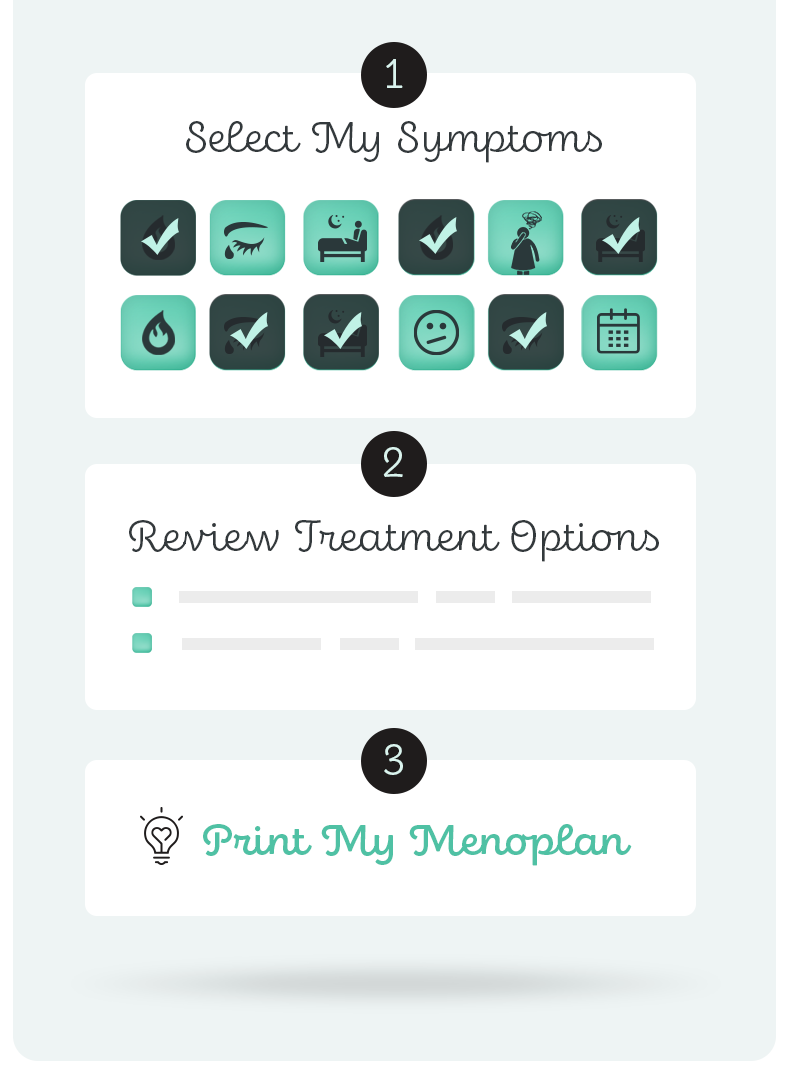Symptoms
HOT FLASHES & NIGHT SWEATS
WHAT IS IT?
A hot flash (night sweat when it happens at night) is a sudden feeling of warmth that often appears to occur without reason. It is most often felt in the torso, neck and face. There may be sweating, flushing or redness in the face, neck, and chest, palpitations, and feelings of anxiety. A hot flash usually lasts about 2-10 minutes. It may be followed by a feeling of chilliness. Intensity varies from a feeling of mild warmth to intense heat.
WHAT’S HAPPENING TO MY BODY?
While hot flashes and night sweats have many causes, the most common cause in mid-life women is entering the menopause transition. During the transition, the hypothalamus (a part of the brain that controls temperature and other functions) appears to mistake small increases in body temperature as a signal that a woman is too warm. It then sends signals to help the woman cool down. Blood vessels near the skin dilate to help the body give off heat. Sweating is another cooling mechanism.
WHAT TO EXPECT
Up to 80% of women have hot flashes and/or night sweats during the menopause transition and postmenopause. About 30-50% of these women say they are frequent or severe. There seem to be four general patterns.
- Symptoms start early in the menopause transition and stop at menopause (when periods stop completely).
- Symptoms start later in the menopause transition but continue in the postmenopause.
- Very mild or no symptoms.
- Symptoms start long before the last menstrual period and continue long into the postmenopausal period.
How long do hot flashes last? A large U.S. study followed women through the menopause transition and postmenopause. In that study, the median total duration of frequent or moderate to severe hot flashes/night sweats was 7.4 years (this means that for half of women hot flashes lasted less than 7.4 years and for half they lasted longer than 7.4 years). The median duration after the last menstrual period was 4.5 years.
For women who were premenopausal or in the early perimenopause when they started having hot flashes, the median was greater than 11.8 years and they continued for a median of 9.4 years after the last menstrual period.
The median duration varies by race/ethnicity. The longest duration is in African-American women (10.9 years) followed by Japanese women (9.4 years), non-Hispanic white women (9.0 years), Chinese women (5.5 years) and Hispanic women (4.8 years).
Treatments that are inappropriate or have not been studied for this symptom are not listed.
Please scroll beyond “References” to access more resources if you are browsing on mobile or tablet
Avis NE, Crawford SL, Greendale G, Bromberger JT, Everson-Rose SA, Gold EB, Hess R, Joffe H, Kravitz HM, Tepper PG, Thurston RC. Duration of menopausal vasomotor symptoms over the menopause transition. JAMA Intern Med. 2015 Apr;175(4):531-9. doi:10.1001/jamainternmed.2014.8063. PMID: 25686030.
Thurston RC. Vasomotor symptoms: natural history, physiology, and links with cardiovascular health. Climacteric. 2018 Apr;21(2):96-100. doi:10.1080/13697137.2018.1430131. PMID: 29390899.
Authors: Dr. Katherine Newton & Dr. Leslie Snyder. Last reviewed: April, 2021
TRACK MY HOT FLASHES
Use this Hot Flash Diary to see how many you have and how much they bother you.



